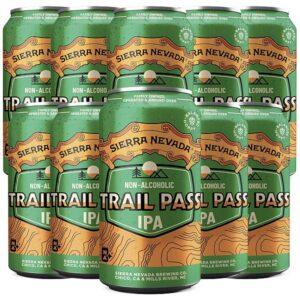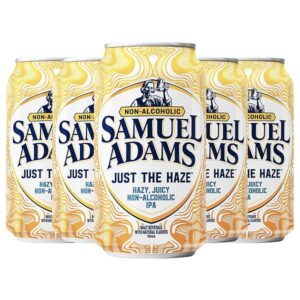Let’s be honest, there was a time when non-alcoholic (NA) beer had a pretty bad reputation. It was often watery, overly sweet, and lacked the depth of real beer. But these days? Craft breweries have stepped up their game, making low and no-alcohol beers that are genuinely delicious.
So how do they do it? Since alcohol plays a huge role in how beer tastes and feels, taking it out (or keeping it to a minimum) isn’t as simple as just brewing a beer and then stripping out the booze. It requires a mix of creativity, science, and some pretty clever brewing techniques.
In this post, we’ll break down how brewers are crafting flavorful, satisfying NA and low-ABV beers that don’t feel like a compromise. Learning how breweries accomplish this will also shed some light on why non alcoholic beers are more expensive than their traditionally brewed versions.
Why Making Great NA Beer Is Tricky
Alcohol does more than just get you buzzed, it contributes body, mouthfeel, and balance to beer. It helps carry aromas, rounds out bitterness, and adds a certain weight that makes a beer feel “right.” When you take alcohol away, you risk ending up with something thin, sweet, and kinda lifeless.
But modern brewers have figured out ways to keep the flavor, body, and complexity of beer while reducing or eliminating alcohol. Let’s dive into how they pull it off.
The Main Ways Breweries Make Low and No-Alcohol Beer
Tweaking Fermentation
One of the easiest ways to keep alcohol low is by limiting fermentation…basically, controlling how much sugar turns into alcohol. Brewers do this in a few different ways:
- Using special yeast strains – Some yeasts naturally produce less alcohol while still creating complex flavors. For example, Saccharomycodes ludwigii is a favorite for non-alcoholic beers because it ferments just enough to add depth without too much booze.
- Keeping fermentation cold – Yeast slows down in colder temps, meaning it won’t produce as much alcohol but can still add a bit of character.
- Brewing with less fermentable sugar – Not all sugars in malt are equally fermentable. By choosing malts that leave more unfermentable sugars, brewers can create a fuller bodied beer without cranking up the alcohol.
This approach is great for keeping the natural flavors intact, but it can sometimes leave the beer tasting a little too sweet or unbalanced. That’s where more advanced methods come in.
Removing Alcohol After Brewing
Some breweries make a full strength beer first and then remove the alcohol. This is trickier than it sounds because if you’re not careful, you can lose a lot of the beer’s flavor along with the alcohol. The best breweries use methods that preserve the good stuff while gently taking out the ethanol:
- Vacuum distillation – By lowering the air pressure in a vacuum chamber, alcohol can be evaporated at a much lower temperature than normal (around 86°F instead of 173°F), so you lose less flavor.
- Reverse osmosis – This fancy filtration system removes alcohol while keeping the rest of the beer’s compounds intact, then adds back water to balance things out.
- Low temperature evaporation – A controlled, gentle heating process that removes alcohol without cooking away the delicate flavors.
These methods allow brewers to start with a fully developed beer and keep it tasting like beer, just without the booze.
Rebuilding Flavor & Mouthfeel
Taking alcohol out isn’t enough. Brewers also have to make sure the beer still tastes great. That means adjusting ingredients and techniques to bring back some of the richness and balance that alcohol usually provides. Here are a few techniques:
- Dry-hopping – Hops are loaded with flavorful and aromatic oils. By adding them late in the brewing process (aka dry hopping), brewers can amp up aroma and complexity without increasing bitterness.
- Using specialty malts & grains – Oats, rye, and other high protein grains add body and texture, making the beer feel more substantial instead of thin and watery.
- Reintroducing aromas – Some breweries even collect the aroma compounds that are lost during alcohol removal and put them back in afterward, bringing back some of the complexity.
This is how brewers make sure NA beers don’t just taste like flavored carbonated water…they have depth, balance, and character.
The Future of Low and No-Alcohol Beer
Non-alcoholic beer has come a long way, and it’s only getting better. Some of the coolest innovations happening right now include:
- New yeast strains that create even more complexity without producing much alcohol.
- Better dealcoholization techniques that remove alcohol more gently while preserving flavor.
- A wider range of styles…we’re already seeing NA stouts, sours, and hazy IPAs, and brewers are pushing the boundaries even further.
With craft brewers putting serious effort into these beers, the days of bland, watery NA options are over. If you haven’t tried one lately, you might be surprised at just how good they’ve become.
Brewing an amazing non-alcoholic or low-ABV beer isn’t easy, but the best breweries are making it happen. By carefully tweaking fermentation, using smart alcohol removal techniques, and adjusting flavors, they’re creating NA beers that actually taste like beer…flavorful, balanced, and refreshing.
So next time you want a beer but don’t want the buzz, give one of these new-school NA brews a shot. You just might find a new favorite!
Tell us about your favorite NA and low alcohol beers in the comments section below.


Leave a Reply